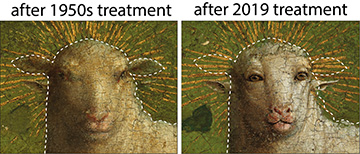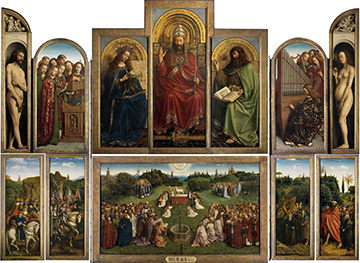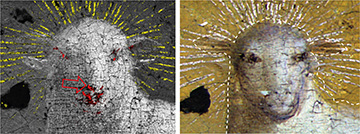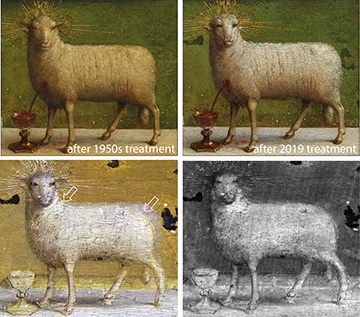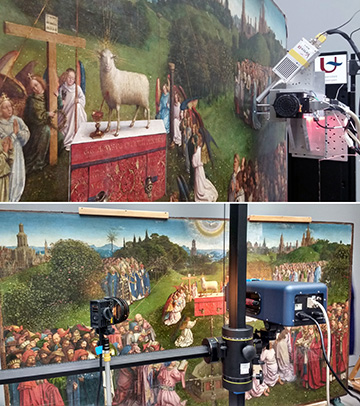The use of hyperspectral techniques revealed that the Lamb of God, a central motif of the 15th-century masterwork the Ghent Altarpiece, originally had a much more expressive face than had appeared even after a restoration in the 1950s. The hyperspectral data were used to guide a new restoration of the painting unveiled at the end of 2019. The dotted lines indicate the outline of the head before removal of overpainting by 16th century restorers. [Image: © Lukasweb.be - Art in Flanders vzw] [Enlarge image]
At the end of 2019, art-history buffs got a rare treat: a new perspective on the Ghent Altarpiece, a 15th-century Flemish religious painting widely recognized as a core masterpiece of Western European art. As was reported last December, conservators working on a restoration of the altarpiece had revealed that overpainting by later artists in the 16th century had significantly distorted the character of the work’s central motif—the Lamb of God, an iconographic rendering of Christ. When those overpainted layers were removed to uncover the work of the original artists, the Lamb turned out to have an uncannily human gaze.
Now, in a new paper, scientists from Belgium and the United States have described the optical techniques used to tease out these secrets and help guide the restoration unveiled in December (Sci. Adv., doi: 10.1126/sciadv.abb3379). The work rested on a combination of two complementary hyperspectral techniques—macroscopic X-ray fluorescence (MA-XRF) and infrared reflectance imaging spectroscopy (RIS). Together, those methods were able to optically and noninvasively pick apart the multiple layers of paint, helping to guide art conservators in the painstaking work of revealing the Lamb’s secrets.
Multi-panel masterwork
The inside panels of the Ghent Altarpiece. The Adoration of the Lamb is the center panel of the bottom row. [Image: Wikimedia Commons] [Enlarge image]
Created in 1432 by the brothers Hubert and Jan Van Eyck and housed in St. Bavo’s Cathedral in Ghent, the Ghent Altarpiece is a polyptych—a large religious painting divided into sets of foldable wings, and intended to serve as an altar decoration in a church or cathedral during the early Renaissance. In the case of the Ghent Altarpiece, which includes 12 panels, the focal point is the lower central panel of the unfolded work, The Adoration of the Lamb, which depicts the Lamb of God on an altar, its blood running into a chalice, in keeping with medieval Christian iconography. (Remarkable images of the altarpiece before the most recent restoration work can be found at http://closertovaneyck.kikirpa.be/.)
The last major round of conservation treatment on the altarpiece took place nearly 70 years ago, in 1950–51. At that time, using techniques including X-ray radiography and cross-sectional analysis of tiny samples of the work via optical microscopy, conservators found evidence that parts of the Lamb’s head and body had been painted over by early restorers of the work, likely in the 16th century. But the 1950s technology—while state-of-the-art at the time—lacked sufficient precision for conservators to remove large amounts of overpaint with confidence. As a result, only a small amount of overpaint around the Lamb’s head was removed in the 1950s work.
Revealing overpainted areas
When a new round of analysis and restoration began in the mid-2010s, conservators could take advantage of new tools for a deeper view. To do so, they enlisted the help of Geert Van der Snickt and colleagues at the University of Antwerp, Belgium. “Often, conservators—when they start looking at the surface of paintings—find things that they do not understand,” Van der Snickt told OPN. “And then they look around to see which scientists can help them.”
Van der Snickt and his colleagues provide that help using MA-XRF, which maps the elemental composition of a painted region by measuring fluorescence spectra after the painting is exposed to X-rays. In the first phase of the project, Van der Snickt’s team was able to confirm the suspicion of the conservators that substantial parts of the reverse sides of the altarpiece wings—the ones visible when the artwork is folded shut—had been overpainted by the 16th-century restorers.
The mapping of those overpainted areas by MA-XRF helped boost the conservators’ confidence in the tricky business of peeling off overpainted layers to reveal the original surface painted by the Van Eycks. “If you say that what we see now at the surface is not by Van Eyck, that is a bold statement,” says Van der Snickt. “You have to be sure about it before the decision to start removing that.”
The lead-white problem
Left: Colorized MA-XRF image of the Lamb, showing elemental distribution of gold (yellow), mercury (red) and lead (white). Red arrow shows position of the nostrils of the Lamb as originally painted. Right: False-color infrared RIS image shows underdrawn lines indicating the position of facial features of the Lamb as originally painted by the Van Eycks, including forward-gazing eyes, the division between the lips, and the jawline. [Images: University of Antwerp / National Gallery of Art, Washington] [Enlarge image]
After the first phase was completed, work turned in the late 2010s to the second phase, focusing on the central interior motif, The Adoration of the Lamb. “Knowing what we learned from the reverse side,” Van der Snickt says, “everybody was eager to learn: What about the Lamb? What happened there?”
But while MA-XRF helped reveal a variety of details by signaling the presence of individual elements (mercury, for example, which is a component of the red pigment vermillion), large parts of the Lamb presented a problem for the X-ray technique. Much of the Lamb’s body was painted—both by the Van Eycks and by later restorers—using a pigment known as lead white (hydrocerussite), a lead carbonate hydroxide. Because of the high X-ray absorption coefficient of lead, the elemental mapping of MA-XRF couldn’t penetrate deeply in those areas and resolve the individual layers of paint. Another method was needed.
Enter infrared RIS
In a bit of serendipity, while the Ghent Altarpiece restoration was under way, John Delaney and Kathryn Dooley of the National Gallery of Art, USA, were in The Hague, working on a different project: doing infrared RIS analysis of another masterwork, Woman with a Pearl Earring, by Johannes Vermeer. They were invited to bring their instruments over to help out with the study of the altarpiece in Ghent. “This was a side trip for us,” says Delaney. “We went for a day and set up directly in the museum.”
In addition to changes in the Lamb’s facial features, the analysis revealed that subsequent overpainting had subtly changed the shape of its body. [Images: Top row, © Lukasweb.be - Art in Flanders vzw / bottom row, National Gallery of Art, Washington] [Enlarge image]
Infrared RIS—which, as the name implies, involves taking reflectance spectra from infrared illumination—is a molecular imaging technique that works by looking for absorption features related to particular pigments (such as the hydroxide component in lead white). And, because infrared radiation’s overall absorption by lead is negligible, it could penetrate much deeper than the X-ray method into the areas of the Lamb painted in lead white. “We’re able to visualize all of the layers, down to the original ground layer of paint,” Delaney says.
“The things we cannot see, they can see,” and vice versa, adds Van der Snickt. “By combining our two techniques, we can see a lot more, and have a lot more comprehensive information on the buildup and the materials that are there.”
Technology meets art history
Both MA-XRF and infrared RIS are so-called hyperspectral techniques, meaning that they capture a complete X-ray fluorescence or infrared reflectance spectrum for every pixel of the imaging area. The result of a scan of the painting is thus a so-called data cube including huge volumes of both spatial and spectral information, which then is analyzed using sophisticated data processing undreamed of by the conservators who managed the last round of work on the altarpiece, in the 1950s. “We’re getting hundreds of images in different spectral bands,” says Dooley of the U.S. National Gallery.
Another difference is that both of the imaging techniques used in the work in the 2010s are standoff techniques involving compact, portable instruments. In working with so precious a piece of artwork, Dooley says she “takes some comfort” in the inherently non-destructive, remote nature of the technique—in the RIS case, she notes, the instruments are several feet away from the painting.
In contrast to the sometimes destructive techniques used in the past, both MA-XRF (top) and infrared RIS (bottom) are non-destructive, standoff imaging techniques that don’t require touching the painting. [Images: University of Antwerp / National Gallery of Art, Washington] [Enlarge image]
Delaney adds that the team’s work has benefited hugely from a close partnership with, and generosity of, the instrument vendors and others who help ensure that the unit has “the best camera system to do the job … It’s a unique bond that we really enjoy, and it’s been a big benefit.”
Van der Snickt also stresses the interdisciplinary nature of the work, and the close interactions with art historians required to make sure that the results from the physics and chemistry make cultural sense. “You can’t just let diehard chemists do this kind of work,” says Van der Snickt. “You need people who know both worlds.” Delaney agrees: “You need to have people who know how people painted at that time, to interpret the layers.” If you had only physicists or chemists doing it, he says, “you’d get some really weird conclusions.”
A magnet for technology
In the case of the work in 2019, that scientific–cultural partnership revealed that the original Lamb of God, as painted by the Van Eycks, had a smaller face than the overpainted version, with penetrating, almost thoughtful eyes and more human-looking nostrils and lips. All of those features were revealed when the restorers carefully sheared off the 16th-century overpaint in specific areas, as guided by the optical images.
The team notes in the paper that the possible allegorical meaning of the forward-looking eyes in particular is “part of an ongoing, unpublished scholarly debate.” Some scholars read religious significance into the Lamb’s piercing gaze; others argue that depictions of animals with forward-looking eyes that “directly engage the viewer” may have been common in the art of the time.
In any event, the detailed restoration, enabled by the combination of two hyperspectral techniques, gives those scholars something to talk about. And Van der Snickt notes with interest how technology has been a theme for this painting over the nearly six centuries since its creation.
“When Van Eyck painted this work of art, it was like a technological revolution—painting with oil … he was the first who was able to exploit this new technique in such a superior way. In the 1950s, the restoration again attracted the top technology of the time, X-ray radiography and optical microscopy. And now again, we are looking with the newest technology at this work of art.”

